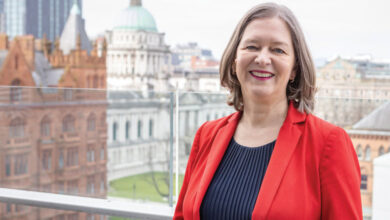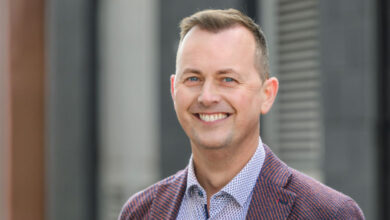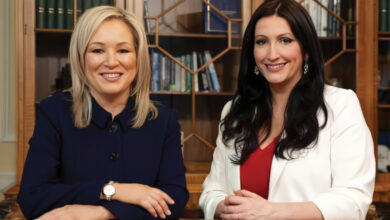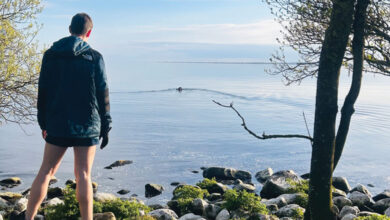Obama’s Republic of Ireland visit: an eternal friendship
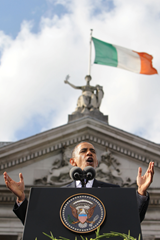 Meadhbh Monahan looked on as President Barack Obama urged Ireland to remain determined because its best days are yet to come.
Meadhbh Monahan looked on as President Barack Obama urged Ireland to remain determined because its best days are yet to come.
“Is féidir linn – yes we can” was the rallying call of President Barack Obama in his address to the estimated 50,000 who packed into Dublin’s College Green and nearby Dame Street to catch a glimpse of one of Ireland’s most famous newly discovered descendants.
A party atmosphere pervaded the crowd who had been whipped up into a frenzy with performances by Jedward, Westlife and other Irish musicians and appearances by actors such as Brendan Gleeson who said: “I am fed up looking at the ground; it is time to stand up.” Sports stars Robbie Keane and Padraig Harrington were on stage and the Irish rugby team captain Brian O’Driscoll, who was carrying the Heineken Cup his Leinster team won in a nail-biting comeback in Cardiff the previous weekend, was met with rapturous applause.
The crowd was ecstatic as Enda Kenny urged them to make their voices heard across the globe in welcoming the 44th President of the United States, who “doesn’t just speak about the American dream, [but] is the American dream.”
True to his eloquent form, Obama wowed all in attendance by telling them that Ireland is a “little country, that inspires the biggest things – your best days are still ahead”.
The Taoiseach referred to the significance of the Queen speaking Irish during her visit. “The Irish harp glittered above the heart of the English Queen. With pride and happiness, and two words of Irish, we closed a circle of our history – a cháirde.”
Obama followed the Queen’s lead, and in his admittedly “broken Irish”, said: “Tá áthas orm bheith in Éirinn – I am happy to be in Ireland.”
Given his identity as America’s first black president and the conspiracy theories about his birthplace, the President quipped: “It turns out that people take a lot of interest in you when you’re running for President.”
He had spent the afternoon in Moneygall, County Offaly, the birthplace of his great- great-great grandfather Falmouth Kearney, who left the village in 1850 to begin a new life in the United States. There, he reviewed the parish records of Templeharry Church of Ireland – which recorded the birth of his forefather and distant branches of his family tree (discovered by genealogists three years ago) – drank a pint of Guinness and spent 90 minutes greeting the crowds who had come to see him and the First Lady Michelle.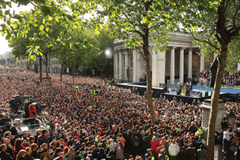
In a speech which appealed to both Irish and American audiences, Obama stated that the reason for his trip was “to reaffirm the bonds of connection” between the two countries which have “a proud, enduring, centuries-old relationship” that is “bound by history and friendship and shared values.”
There is “a little green behind the red white and blue” of the star-spangled banner, according to Obama, who harkened to the Irish who fought for George Washington and Abraham Lincoln, who fought against slavery and who bred the first Irish Catholic President, John F Kennedy.
Defiant endurance
It has been noted that Obama didn’t discuss the financial constraints facing the Irish Government, or commit to any significant American assistance.
Writing in the Irish Times, historian Diarmaid Ferriter said: “There is no doubt that Ireland needs every ally it can get at the moment as those in the EU managing our loan terms seek to keep us afloat and crucify us at the same time. Getting a message through that officially the US establishment shares that assessment could bolster Ireland’s case for a change to the terms.” He wrote that economist Morgan Kelly had revealed that the IMF had planned to burn $30 billion worth of unguaranteed Irish bonds but was stopped by US Treasury Secretary Timothy Geithner.
Ferriter believes: “For all the genuine warmth, excitement and polished rhetoric, it may well be that our connection with Obama will remain simply at the feel-good rhetorical level.”
Obama did note the difficulties facing many families saying: “We all realise that both of our nations have faced great trials in recent years, including recessions so severe that many of our people are still trying to fight their way out. And naturally our concern turns to our families, our friends and our neighbours.”
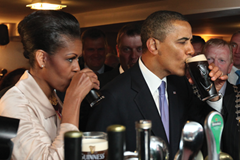 Referring to the famine and the Troubles, Obama continued: “Yours is a history frequently marked by the greatest of trials and the deepest of sorrow. But yours is also a history of proud and defiant endurance. Of a nation that … overcame occupation and outlived fallow fields, that triumphed over its Troubles – of a resilient people who beat all the odds.”
Referring to the famine and the Troubles, Obama continued: “Yours is a history frequently marked by the greatest of trials and the deepest of sorrow. But yours is also a history of proud and defiant endurance. Of a nation that … overcame occupation and outlived fallow fields, that triumphed over its Troubles – of a resilient people who beat all the odds.”
He added: “This is a nation that met its responsibilities – and inspired the entire world – by choosing to see past the scars of violence and mistrust to forge a lasting peace on this island.”
Prompting Ireland to overcome its problems, Obama evoked the word of William Butler Yeats: “In dreams begin responsibility.” The Irish and Americans make their better futures happen through investing in family and community, Obama stated.
He urged the crowds to remember that “if anybody ever tells you that your problems are too big, or your challenges are too great, that we can’t do something … just respond with a simple creed: Is feidir linn. Yes, we can.”
Thanking the Irish people “for all you’ve contributed to the character of the United States of America and the spirit of the world” Obama concluded by asking God to bless “the eternal friendship between our two great nations.”
Anyone who was initially sceptical about Obama’s intentions – claiming his visit was an electioneering tool to appeal to the 40 million Irish American voters, or that it was simply rhetoric – couldn’t deny the level of warmth emanating from the President and his wife and the excitement and happiness radiating from the enormous crowds in Dublin city centre as they witnessed a moment that is certain to go down in Ireland’s history books.

